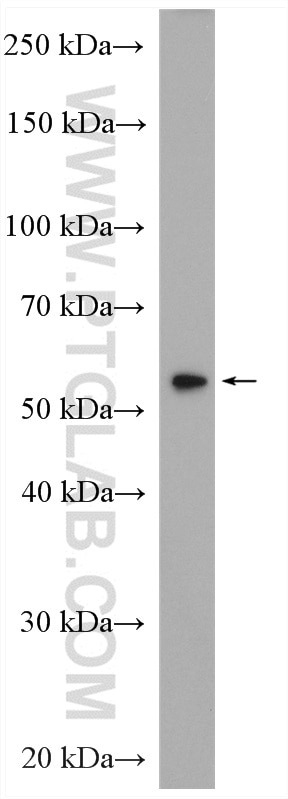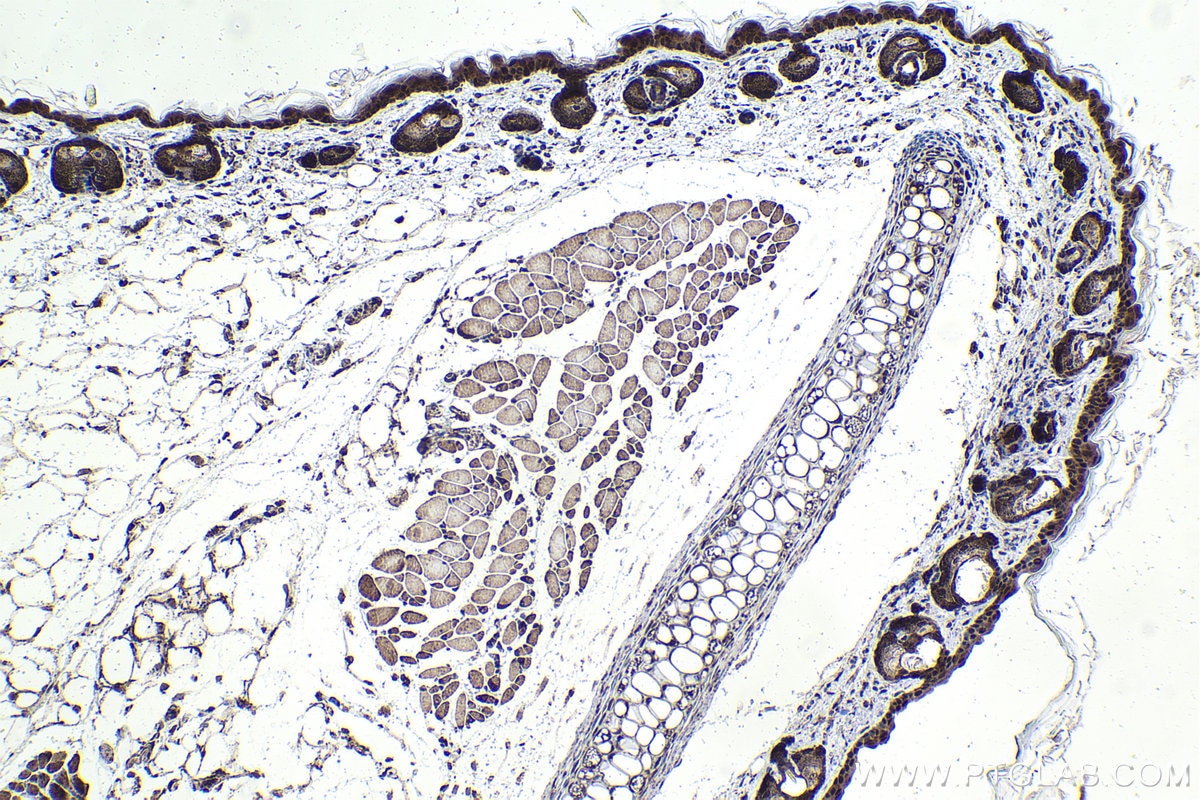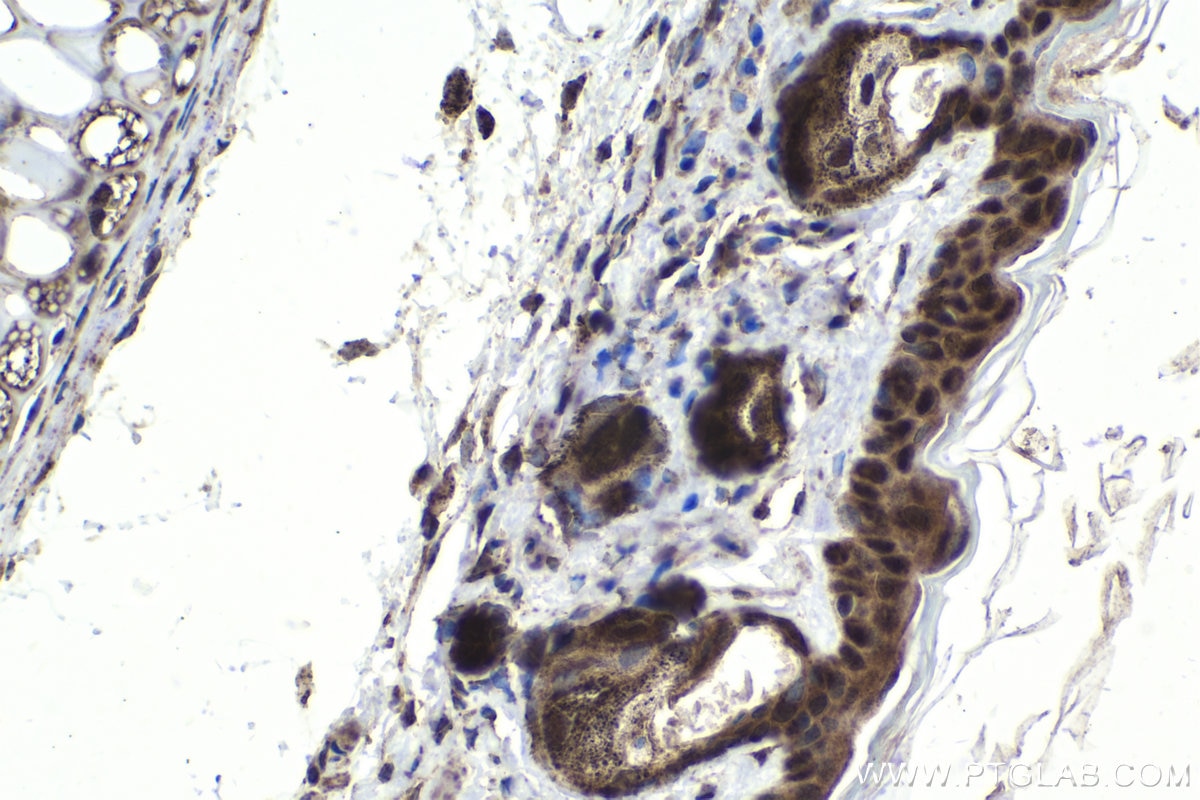Anticorps Polyclonal de lapin anti-IRF7
IRF7 Polyclonal Antibody for WB, IHC, ELISA
Hôte / Isotype
Lapin / IgG
Réactivité testée
Humain, souris
Applications
WB, IF, IHC, ELISA
Conjugaison
Non conjugué
N° de cat : 22392-1-AP
Synonymes
Galerie de données de validation
Applications testées
| Résultats positifs en WB | cellules HEK-293, |
| Résultats positifs en IHC | tissu cutané de souris, il est suggéré de démasquer l'antigène avec un tampon de TE buffer pH 9.0; (*) À défaut, 'le démasquage de l'antigène peut être 'effectué avec un tampon citrate pH 6,0. |
Dilution recommandée
| Application | Dilution |
|---|---|
| Western Blot (WB) | WB : 1:1000-1:4000 |
| Immunohistochimie (IHC) | IHC : 1:250-1:1000 |
| It is recommended that this reagent should be titrated in each testing system to obtain optimal results. | |
| Sample-dependent, check data in validation data gallery | |
Applications publiées
| KD/KO | See 1 publications below |
| WB | See 11 publications below |
| IHC | See 3 publications below |
| IF | See 1 publications below |
Informations sur le produit
22392-1-AP cible IRF7 dans les applications de WB, IF, IHC, ELISA et montre une réactivité avec des échantillons Humain, souris
| Réactivité | Humain, souris |
| Réactivité citée | Humain, souris |
| Hôte / Isotype | Lapin / IgG |
| Clonalité | Polyclonal |
| Type | Anticorps |
| Immunogène | IRF7 Protéine recombinante Ag18059 |
| Nom complet | IRF 7 |
| Masse moléculaire calculée | 516 aa, 56 kDa |
| Poids moléculaire observé | 55 kDa |
| Numéro d’acquisition GenBank | BC136555 |
| Symbole du gène | IRF7 |
| Identification du gène (NCBI) | 3665 |
| Conjugaison | Non conjugué |
| Forme | Liquide |
| Méthode de purification | Purification par affinité contre l'antigène |
| Tampon de stockage | PBS avec azoture de sodium à 0,02 % et glycérol à 50 % pH 7,3 |
| Conditions de stockage | Stocker à -20°C. Stable pendant un an après l'expédition. L'aliquotage n'est pas nécessaire pour le stockage à -20oC Les 20ul contiennent 0,1% de BSA. |
Informations générales
IRF-7 (IFN regulatory factor 7) is a member of the IFN regulatory transcription factor (IRF) family. IRF-7 has been shown to play a role in the transcriptional activation of virus-inducible cellular proteins, including IFN beta chain proteins. Inducible expression of IRF-7 is largely restricted to lymphoid tissue. Four transcript variants encoding distinct isoforms (A,B,C and D) have been identified for this (PMID:9786932).The active IRF7A exists as a dimer form ~80 kDa(PMID:11073981). The MW 67-70 kDa has been reported in some papers (PMID:9786932; 22951831).Various posttranslational modifications of IRF7 including phosphorylation, ubiquitination, sumoylation and acetylation are identified (PMID:22951831).This antibody is a rabbit polyclonal antibody raised against the C-terminal 349 amino acid residues of human IRF7 D. The molecular weight of Nonphosphorylated IRF7 cofractionated with the 44-kDa marker, approximating its predicted size. In contrast, phosphorylated IRF7, which migrate more slowly on SDS-PAGE. This phosphorylated IRF7 was consistent with a size of 80 to 90 kDa. (PMID: 11073981 )
Protocole
| Product Specific Protocols | |
|---|---|
| WB protocol for IRF7 antibody 22392-1-AP | Download protocol |
| IHC protocol for IRF7 antibody 22392-1-AP | Download protocol |
| Standard Protocols | |
|---|---|
| Click here to view our Standard Protocols |
Publications
| Species | Application | Title |
|---|---|---|
Cancer Lett NR4A1 depletion inhibits colorectal cancer progression by promoting necroptosis via the RIG-I-like receptor pathway | ||
Cell Chem Biol Identifying enhancers of innate immune signaling as broad-spectrum antivirals active against emerging viruses. | ||
J Immunol Inducible TAP1 Negatively Regulates the Antiviral Innate Immune Response by Targeting the TAK1 Complex. | ||
J Immunol Inducible ATP1B1 Upregulates Antiviral Innate Immune Responses by the Ubiquitination of TRAF3 and TRAF6. | ||
Phytomedicine Si-Ni-San ameliorates chronic colitis by modulating type I interferons-mediated inflammation. | ||
Cancer Med A regulatory mutant on TRIM26 conferring the risk of nasopharyngeal carcinoma by inducing low immune response. |




